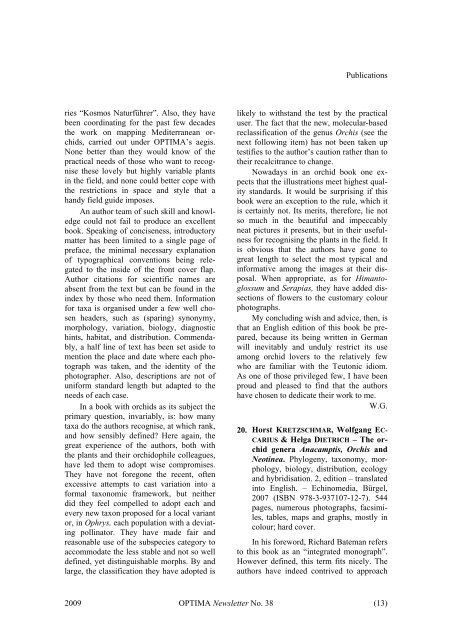OPTIMA Newsletter 38
OPTIMA Newsletter 38
OPTIMA Newsletter 38
Create successful ePaper yourself
Turn your PDF publications into a flip-book with our unique Google optimized e-Paper software.
ies “Kosmos Naturführer”. Also, they have<br />
been coordinating for the past few decades<br />
the work on mapping Mediterranean orchids,<br />
carried out under <strong>OPTIMA</strong>’s aegis.<br />
None better than they would know of the<br />
practical needs of those who want to recognise<br />
these lovely but highly variable plants<br />
in the field, and none could better cope with<br />
the restrictions in space and style that a<br />
handy field guide imposes.<br />
An author team of such skill and knowledge<br />
could not fail to produce an excellent<br />
book. Speaking of conciseness, introductory<br />
matter has been limited to a single page of<br />
preface, the minimal necessary explanation<br />
of typographical conventions being relegated<br />
to the inside of the front cover flap.<br />
Author citations for scientific names are<br />
absent from the text but can be found in the<br />
index by those who need them. Information<br />
for taxa is organised under a few well chosen<br />
headers, such as (sparing) synonymy,<br />
morphology, variation, biology, diagnostic<br />
hints, habitat, and distribution. Commendably,<br />
a half line of text has been set aside to<br />
mention the place and date where each photograph<br />
was taken, and the identity of the<br />
photographer. Also, descriptions are not of<br />
uniform standard length but adapted to the<br />
needs of each case.<br />
In a book with orchids as its subject the<br />
primary question, invariably, is: how many<br />
taxa do the authors recognise, at which rank,<br />
and how sensibly defined? Here again, the<br />
great experience of the authors, both with<br />
the plants and their orchidophile colleagues,<br />
have led them to adopt wise compromises.<br />
They have not foregone the recent, often<br />
excessive attempts to cast variation into a<br />
formal taxonomic framework, but neither<br />
did they feel compelled to adopt each and<br />
every new taxon proposed for a local variant<br />
or, in Ophrys, each population with a deviating<br />
pollinator. They have made fair and<br />
reasonable use of the subspecies category to<br />
accommodate the less stable and not so well<br />
defined, yet distinguishable morphs. By and<br />
large, the classification they have adopted is<br />
Publications<br />
likely to withstand the test by the practical<br />
user. The fact that the new, molecular-based<br />
reclassification of the genus Orchis (see the<br />
next following item) has not been taken up<br />
testifies to the author’s caution rather than to<br />
their recalcitrance to change.<br />
Nowadays in an orchid book one expects<br />
that the illustrations meet highest quality<br />
standards. It would be surprising if this<br />
book were an exception to the rule, which it<br />
is certainly not. Its merits, therefore, lie not<br />
so much in the beautiful and impeccably<br />
neat pictures it presents, but in their usefulness<br />
for recognising the plants in the field. It<br />
is obvious that the authors have gone to<br />
great length to select the most typical and<br />
informative among the images at their disposal.<br />
When appropriate, as for Himantoglossum<br />
and Serapias, they have added dissections<br />
of flowers to the customary colour<br />
photographs.<br />
My concluding wish and advice, then, is<br />
that an English edition of this book be prepared,<br />
because its being written in German<br />
will inevitably and unduly restrict its use<br />
among orchid lovers to the relatively few<br />
who are familiar with the Teutonic idiom.<br />
As one of those privileged few, I have been<br />
proud and pleased to find that the authors<br />
have chosen to dedicate their work to me.<br />
W.G.<br />
20. 19BHorst KRETZSCHMAR, Wolfgang EC-<br />
CARIUS & Helga DIETRICH – The orchid<br />
genera Anacamptis, Orchis and<br />
Neotinea. Phylogeny, taxonomy, morphology,<br />
biology, distribution, ecology<br />
and hybridisation. 2, edition – translated<br />
into English. – Echinomedia, Bürgel,<br />
2007 (ISBN 978-3-937107-12-7). 544<br />
pages, numerous photographs, facsimiles,<br />
tables, maps and graphs, mostly in<br />
colour; hard cover.<br />
In his foreword, Richard Bateman refers<br />
to this book as an “integrated monograph”.<br />
However defined, this term fits nicely. The<br />
authors have indeed contrived to approach<br />
2009 <strong>OPTIMA</strong> <strong>Newsletter</strong> No. <strong>38</strong> (13)






